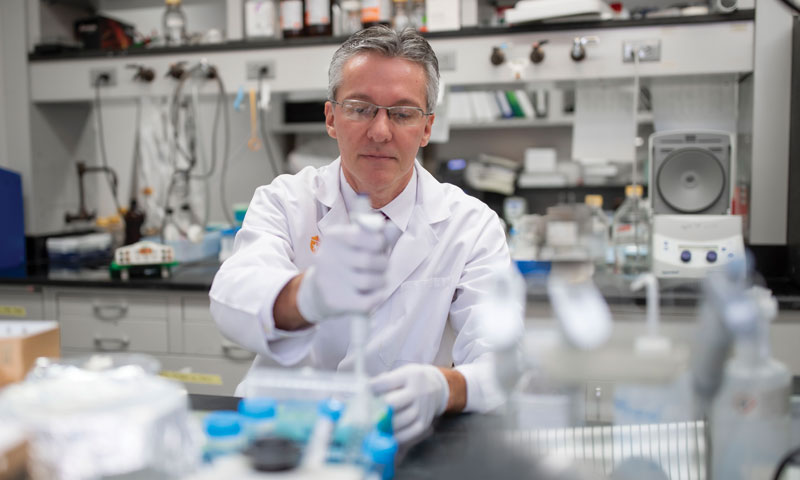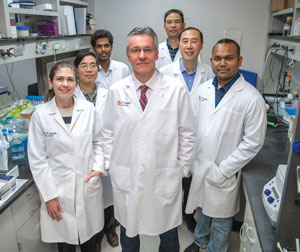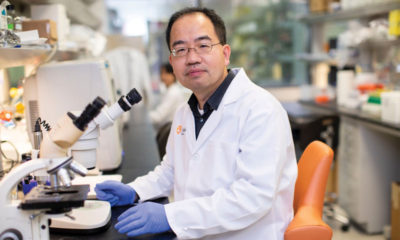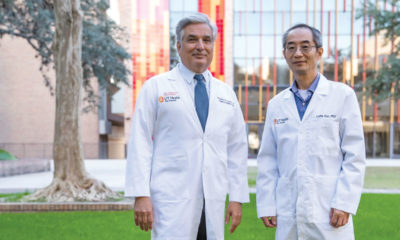Clinical trial tests FDA-approved drug to treat diffuse large B-cell lymphoma

Mays Cancer Center Annual Report
Ricardo Aguiar, M.D., Ph.D., professor of medicine and vice chief for research in the Division of Hematology and Medical Oncology for the Long School of Medicine, is conducting research with the potential for finding a cure for patients who are diagnosed with diffuse large B-cell lymphoma (DLBCL).

Patients diagnosed with DLBCL are given a standard of care treatment consisting of a combination of the drugs rituximab, cyclophosphamide, doxorubicin hydrochloride, oncovin and prednisolone, referred to as R-CHOP. Under Dr. Aguiar’s direction, patients in his clinical trial at the Mays Cancer Center are receiving the standard of care R-CHOP treatment plus roflumilast, a drug that acts as an inhibitor of the enzyme phosphodiesterase 4 (PDE4).
Because roflumilast has already been approved by the FDA to treat patients with chronic obstructive pulmonary disease (COPD), Dr. Aguiar’s initiative can circumvent some of the lengthy delays associated with translating basic biology knowledge into clinical activities. In clinical-trial terms, Dr. Aguiar and his collaborators are testing the repurposing of the drug for its use in cancer patients.
In an earlier phase I clinical trial completed in 2017, Dr. Aguiar and his colleagues tested the safety of roflumilast on B-cell lymphoma patients who had received traditional standard-of-care treatment without positive results. Data from that first trial, showed that roflumilast was safe, well tolerated, and active in a highly refractory patient population.
Those positive results gave the impetus to Dr. Aguiar and co-investigator Enrique Diaz, M.D., to open the current trial, now underway for more than a year, that tests the safety of the combination of roflumilast and R-CHOP on previously untreated DLBCL patients. Of the five patients currently in the study, results appear promising.
Dr. Aguiar hypothesizes that the PDE4 inhibitor roflumilast works on two, if not more, fronts against DLBCL. First, as his group has shown in pre-clinical models, he theorizes that PDE4 inhibitors suppress the activity of the B-cell receptor, a physiologic component of normal B lymphocytes that is hijacked by the lymphoma cells to promote their own excessive growth.
Secondly, roflumilast inhibits the vessels in the tumor microenvironment. He explains that cancers develop their own vasculature, with the tumor eating more than a regular cell because it needs more food and oxygen. To handle the increased need, the tumor increases the blood vessels in the area. By suppressing the vasculature, as roflumilast does, the tumor cells are starved and perish.
“We’ll be able to tell in six to 12 months if the combination of roflumilast and R-CHOP is safe and active, which will allow us to open a trial that compares side-by-side classical R-CHOP with roflumilast plus R-CHOP,” he says. That randomized trial will be conducted in untreated DLBCL patients to conclusively validate or refute the hypothesis that PDE4 inhibition is an effective strategy to treat DLBCL.
Dr. Aguiar first began work on this project in 2002 while at the Dana-Farber Cancer Institute at Harvard Medical School. At the time, he worked on one of the first unbiased studies to determine what made a B-cell lymphoma either very aggressive or curable. The study found that PDE4 was highly expressed in “fatal” tumors, making them prime candidates for PDE4 inhibition. Enter roflumilast, which is a PDE4 inhibitor. The current Phase IB study is designed for a cohort of 10 patients. They have reached half that number, with a significant fraction of those patients being of Hispanic ethnicity and hope to reach the maximum number of patients in the next few months.
Dr. Aguiar, holder of the Bessie Bell Dean “Bebe” Bowen Cancer Research Endowment, is an M.D. with clinical training in hematology and oncology, and a Ph.D. in the field of leukemia.
He did his post-doctoral training at the Hammersmith Hospital, University of London, and at Dana-Farber Cancer Institute, where he broadened his expertise in both leukemia and lymphoma biology.
He currently spends about 25 percent of his working hours on this study. Funding comes from the Leukemia & Lymphoma Society (LLS), the Cancer Prevention and Research Institute of Texas (CPRIT), private foundations, and individual philanthropists such as Ann Vineyard, who is a member of the SA Cancer Council Board and assistant chair of the Council’s Circle of Hope program.
“I am forever grateful to Ann who funded one of my first pilot research projects in this study a few years ago and recently provided an additional contribution through a new Circle of Hope to further advance this important research,” explained Dr. Aguiar. “This is another example of generous support from caring donors like Ann that enables studies like this to advance to the next level, providing real hope for countless cancer patients today and in the future.”
What does this study mean for patients? The potential is significant as 75,000 people in the United Stated are newly diagnosed with lymphoma each year, with approximately 25,000 of those cases defined as diffuse large B-cell lymphoma.
“If our concept is correct and we can improve the survival rate of DLBCL, the numbers are staggering. Sixty percent of patients with DLBCL survive with R-CHOP only. It leaves 40 percent that are likely to die of their disease. We are talking about nearly 10,000 people without a cure, every year. If we can improve the overall response rate by 10 percent to 15 percent, the positive numbers start to accumulate — 2,500 to 3,000 (saved) per year, 25,000 to 30,000 in 10 years,” he says.
“More people are now going to survive DLBCL. It’s a great reason to be doing this,” he added, “and donors like Ann Vineyard, LLS, CPRIT, and many others are helping to make it happen.”




